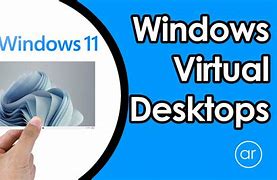Virtual desktops are not a new concept in Windows. In Windows 10, it was simple to create a separate desktop so that you could, for example, have one desktop for one project and another for another, or one for work and another for personal apps.
However, there has been an upgrade to Windows 11. You can now have a different wallpaper for each desktop, making it easier to distinguish one from the other (and providing you with a different mood depending on what you’re using it for). Several other features make using virtual desktops simple and efficient. Some of these were introduced in Windows 10, but when combined with the new features of Windows 11, they form a useful toolbox.
CREATE A VIRTUAL DESKTOP
To create a new virtual desktop, follow these steps:
- Hover your mouse over or click the “Task view” icon in your taskbar (it looks like one square superimposed on another).
- Select “New desktop” from the thumbnail list.
You can also use the key combination Win+Ctrl+D, which will take you directly to your new desktop.
You can now put different apps on different desktops. By clicking the “Task View” icon, you can switch from one desktop to the other. (You can also move around by pressing the Alt-Tab key combination, which will take you to all the apps on one desktop and then to all the apps in the next.)
To remove a desktop:
- Hover your mouse over or click the “Task view”icon.
- Hover your cursor over the virtual desktop you want to delete and click the “X” in the upper right corner.
DESKTOPS CAN BE PERSONALIZED
You can now personalize your desktops in Windows 11, making it easier to dedicate each one to a specific function. There are several approaches to this.
SELECT A DIFFERENT WALLPAPER
Each virtual desktop can have a unique background. It’s very simple:
- In the taskbar, select the “Task view” icon.
- Right-click on the desktop you want to change and select Change Desktop.
- Select “Choose background.”
This will take you to the Personalization > Background page, where you can choose between a background image, a solid color, or a slideshow. You can then browse your photos for the image(s) you want to use and select the type of fit you want for your image (for example, you can tile or stretch the image).
CHOOSE A DESKTOP NAME
Your desktops will be given the rather dull titles “Desktop 1,” “Desktop 2,” and so on. You can easily change this by giving each desktop a name.
- Hover your mouse over the “Task view” icon.
- Click on the desktop whose name you want to change.
- Enter the new name here.
REARRANGE YOUR DESKTOPS
You might want to rearrange the desktops to make it easier to remember which to use when. This is also very straightforward.
- Hover your mouse over the “Task view” icon.
- Click and hold the desktop you want to reposition, then drag it to its new location.
USE THE SAME APP ON DIFFERENT DESKTOPS
If you open an app on one desktop and then open it on another, you will be using a different version of that app — for example, you can use Chrome to look at Twitter on one desktop and do some work research on another. (Note that some apps may not yet work this way — for example, when I tried to open Notion on a second desktop, my computer jumped to the desktop where it was already open.)




